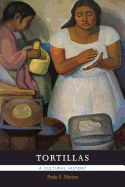
There is a saying in Mexico: sin maíz, no hay país ("without corn, there is no country"). For many South Americans, corn tortillas represent the staff of life, just as wheat bread does for Europeans. These hand-patted disks of fresh maize trace their roots to ancient Mesoamerica, where the tortilla held important ceremonial functions in addition to providing sustenance. In Tortillas: A Cultural History, journalist and former farmer Paula E. Morton (Tabloid Valley) outlines the powerful forces that fueled the rise of this "life-giving" food from intimate-country-kitchen staple to large-scale, mass-produced global commodity with cross-cultural appeal.
Even as Spanish conquistadors threatened to displace fallow cornfields with cattle and wheat in the 1500s, it was not bread that the Spaniards used to appease their own hunger but the versatile and hardy tortilla (wrapped around meat and beans). As pioneers migrated westward on the Ox Bow Trail during the late 1800s, they turned away from costlier staples (eggs and butter) in favor of the inexpensive burrito. When mechanization and industrialization threatened to homogenize the tortilla in the late 20th century, mom-and-pop shops in local neighborhoods kept tortilla-making traditions alive.
Morton's slim book provides an illuminating look at the importance of the tortilla in bridging culture and history--a commodity that has never gone out of style despite the rocky political, economic, social and racial divides that have threatened its existence. "The tortilla," writes Morton, "crosses cultures, a consequence of the flow of people, ideas, technology and trade." For many, the tortilla is still the taste that connects them to the motherland. --Nancy Powell, freelance writer and technical consultant

